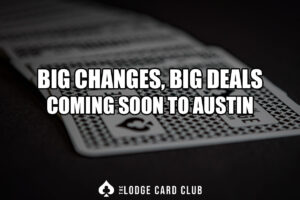Omaha is one of the most popular games played at the Lodge, both in cash game and tournament format.
Omaha is a poker variant in which all players must use exactly two hole cards and three community cards to make the best five-card hand. Omaha plays similarly to Texas Hold’em in terms of its status as a community card poker game, but there are some significant differences in the rules.
Like all poker variants, tournament Omaha plays differently than cash game Omaha. This article will focus on the rules and structure of Omaha poker tournaments.
What Is Omaha Poker?
As mentioned, Omaha is a poker game that shares many common traits with Texas Hold’em. Omaha is a community card poker game that uses a betting system that includes blinds and a button.
In most Omaha variants, players receive four hole cards. Some Omaha games see players get five or even six hole cards, however.
The game begins with a preflop betting round, followed by three subsequent betting rounds known as the flop, turn, and river.
The dealer puts out the first three of five community cards (cards that all players can use) in the flop betting round. A fourth community card is dealt on the turn, and the fifth and final community card is dealt on the river.
Players must use exactly two hole cards and three community cards in an effort to make the best five-card hand. This differs from Texas Hold’em, in which players can use any combination of hole cards ad community cards.
Omaha uses standard poker hand rankings to determine which player has the best high hand. Some versions of Omaha split the pot between the player with the best high hand and the best qualifying low hand.
Some of the different variations of Omaha include:
Pot-Limit Omaha (PLO)
Pot-Limit Omaha is the second-most popular poker game in the world, behind No-Limit Texas Hold’em.
PLO games see each player get dealt four hole cards, with a pot-limit betting structure used. The biggest bet or raise possible at any given time is equal to the size of the pot.
Pot-Limit Omaha games award the pot to the player who has the best high hand at showdown.
For more on PLO, check out our guide to how to play Pot-Limit Omaha.
Omaha Hi-Lo
Omaha Hi-Lo splits the pot between the player with the best high hand and the player with the best qualifying low hand.
A qualifying low hand must have no cards higher than an eight, and must contain no pairs, three of a kind, full house, or four-of-a-kind combinations. The best possible qualifying low hand in Omaha Hi-Lo is A-2-3-4-5 (straights and flushes don’t count against the low).
If there’s no qualifying low hand, the player with the best high hand wins the entire pot (aka “scoops” the pot).
Omaha Hi-Lo is generally played with a limit betting structure, which means bet and raise sizes are determined by the blinds and limits of the game.
Big-O
Big-O is one of the most popular games on the Lodge schedule. Big-O is just like Omaha Hi-Lo, except that each player starts with five hole cards.
The rules are the same, however, in that all players must use exactly two hole cards and three community cards to make the best five-card hand. With the extra hole card in play, you’ll often need a very strong hand to win the high portion of the pot.
Big-O games at the Lodge are played with a limit betting structure.
For more on Big-O, check out our guide to how to play Big-O.
How Does An Omaha Poker Tournament Work?
When you look at the games available at the Lodge (or any poker room for that matter), you’ll see two kinds of games – cash games and tournaments.
Omaha tournaments and Omaha cash games both have the same poker variant at their core. Poker tournaments and poker cash games are quite different, however.
In a tournament, you pay a predetermined buy-in and get a set amount of chips. All players pay the same amount for the buy-in, and all players start with the same amount of chips.
When you lose all of your chips in a tournament, you’re eliminated. The object of a tournament is to outlast other players until you make it to the money stage of the event. Most poker tournaments see the final 10-20 percent of players reach the payout stage.
The tournament proceeds until one player wins all of the chips in play. That player wins the tournament and collects the first-place prize.
In poker cash games, you buy in for any amount of money you wish, as long as it’s within the range allowed in that game. If you buy in for $500, you get $500 worth of chips to put on the table.
You and other players compete for the exact dollar amounts that each player puts on the table. This differs from tournaments, in which the tournament chips don’t actually have a cash value.
Let’s take a look at an example Omaha tournament from the Lodge schedule:
The Wednesday Night $5K Guaranteed PLO Freeroll
- Buy-In: $30
- Starting Stack: 15,000 chips
- 15-minute levels (late entry allowed through Level 9)
- $5,000 guaranteed prize pool
- Up to five re-buys and five add-ons allowed
The Wednesday PLO tournament comes with a $30 entry fee. That buy-in gets you 15,000 chips, and all players have the same starting stack of 15,000 chips at the start of the tournament.
When the tournaments begins, the blinds start at 100/100, (100 for the small blind and 100 for the big blind). The blind amounts increase every 15 minutes.
The escalating blinds are mandatory in poker tournament play, preventing players from just sitting around waiting for other players to bust out. The tournament structure for the Wednesday PLO Freeroll looks like this:
- Level 1: Blinds 100/100
- Level 2: Blinds 100/200
- Level 3: Blinds 200/300
- Level 4: Blinds 200/400
- Level 5: Blinds 300/600
- Level 6: Blinds 400/800
- Level 7: Blinds 500/1000
- Level 8: Blinds 600/1200
- Level 9: Blinds 1000/1500
Your 15,000 starting stack is worth 150 big blinds when you start this Pot-Limit Omaha tournament. Two hours into the events, however, that 15,000-chip stack is only worth about 12 big blinds.
The increasing blinds force players to play hands, try to make moves, and win pots. Late registration is allowed through the end of Level 9, but if you wait that long to buy into the tournament, you’ll start off with 10 big blinds.
This particular Omaha tournament allows re-buys and add-ons. You can re-buy any time your stack drops below 15,000, in 10,000-chip increments for $20 each. You can rebuy for up to 50,000 extra chips (which would cost a total of $100).
You can also purchase up to five 10,000-chip add-ons for $20 each, separately from the re-buys. Add-ons are available at the first break of the tournament, after Level 4. You can purchase the add-ons no matter how many chips you have in front of you.
Whether an Omaha poker tournament has re-buys and add-ons or not, the object remains the same – outlast the field by not losing all of your chips. Once the late registration period ends, there are no more re-buys, add-ons, or late registration.
The tournament then plays on, with the blinds continuing to increase every 15 minutes. The event continues until only one player has chips.
Omaha tournaments are very popular at the Lodge. The weekly Lodge schedule includes the following Omaha events:



